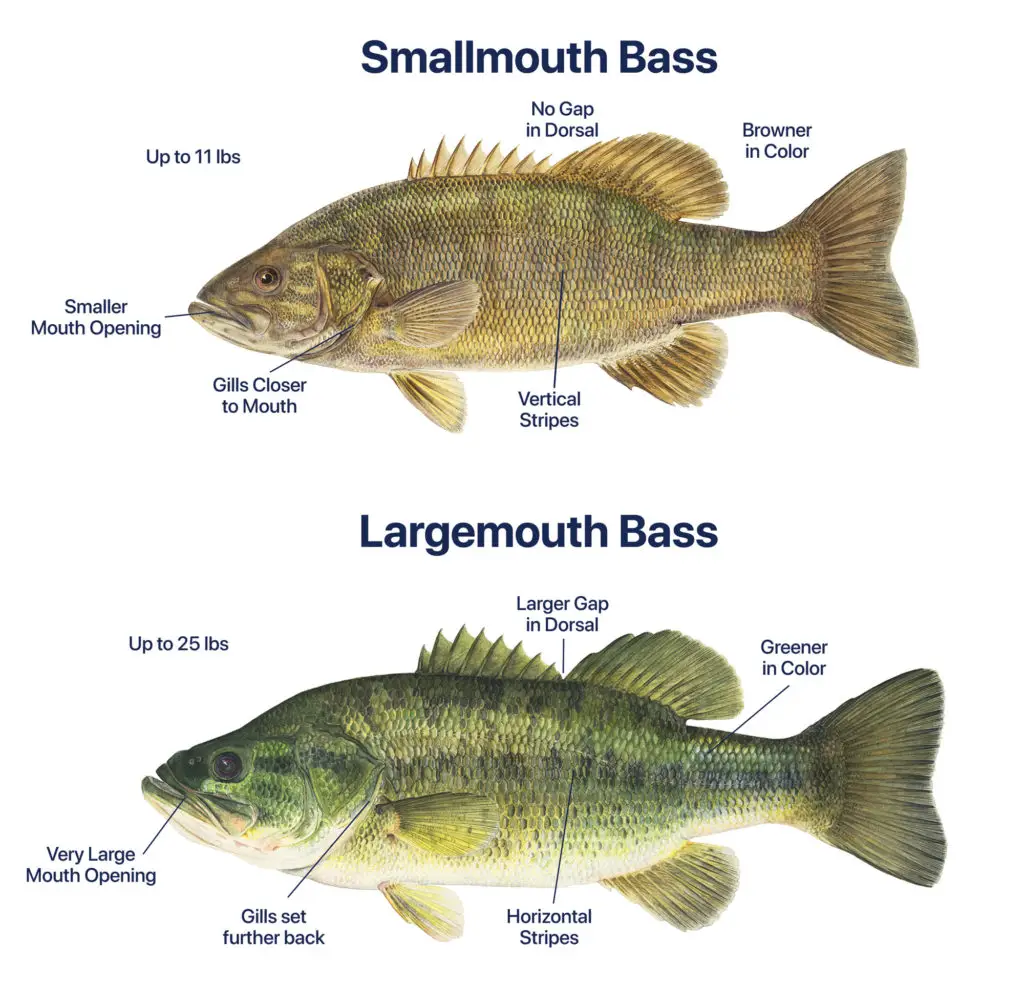Largemouth vs smallmouth bass

Largemouth bass and smallmouth bass have distinct preferences when it comes to their habitat. Largemouth bass typically inhabit warm, shallow waters with ample vegetation, such as lakes, ponds, and slow-moving rivers. They are often found lurking in the shadows of lily pads, submerged logs, or other structures that provide cover for ambush-style hunting.
On the other hand, smallmouth bass prefer cooler, clearer waters with rocky structures. They are commonly found in rivers, streams, and reservoirs, where they seek shelter among rocks and boulders. Their affinity for such habitats can be attributed to their evolutionary adaptation, as the rocky structures provide ideal conditions for smallmouth bass to thrive.
Size
One of the most noticeable differences between largemouth bass and smallmouth bass is their size. Largemouth bass generally grow larger than their smallmouth counterparts. In optimal conditions, largemouth bass can reach impressive sizes of up to 2 feet in length and weigh over 20 pounds. In comparison, smallmouth bass usually grow to about 12 to 16 inches in length and weigh between 1 to 5 pounds.
Coloration
The coloration of largemouth bass and smallmouth bass is another distinguishing factor. Largemouth bass have a dark green color on their upper body with a lighter belly. They often exhibit a lateral black stripe running along their side, which provides effective camouflage in their habitat. Smallmouth bass, on the other hand, have a bronze or brownish coloration with vertical bars on their sides. These markings help them blend in with the rocky environments they inhabit.
Mouth Size
The most apparent physical difference between largemouth bass and smallmouth bass lies in their mouth size. Largemouth bass have a larger mouth that extends beyond the eye, giving them a distinctive appearance. This larger mouth enables them to engulf and devour larger prey items. In contrast, smallmouth bass have a smaller mouth that does not extend as far back, limiting the size of prey they can consume.
Feeding Behavior
Largemouth bass and smallmouth bass exhibit different feeding behaviors, which contribute to their respective hunting strategies. Largemouth bass are well-known for their ambush-style feeding behavior. They prefer to lie in wait, hiding among vegetation or structures, and strike at passing prey with remarkable speed and precision. This approach allows them to capitalize on unsuspecting prey that comes within their reach.
Smallmouth bass, however, are more active predators. They have a tendency to chase down their prey in open water, relying on their agility and speed to capture smaller fish, crayfish, and insects. This active hunting style makes smallmouth bass a formidable opponent for anglers and adds to their reputation as acrobatic fighters.
Fighting Abilities
Speaking of fighting abilities, smallmouth bass are renowned for their remarkable strength and acrobatic prowess. Anglers often regard them as stronger and more agile fighters compared to largemouth bass. When hooked, smallmouth bass display spirited jumps and intense resistance, making them a thrilling catch. Their tenacity and endurance during the fight make them a favorite among anglers seeking an exhilarating fishing experience.
Preferred Prey
While both largemouth and smallmouth bass are opportunistic predators, their preferred prey can vary. Largemouth bass have a more diverse diet and tend to consume larger prey items. They are known to feed on fish, frogs, and even small mammals that happen to venture near the water's edge. Smallmouth bass, on the other hand, primarily feed on smaller fish, crayfish, and insects. Their diet is more focused on the available aquatic life in their rocky habitats.
Spawning Habits
Largemouth bass and smallmouth bass differ in their spawning habits as well. Largemouth bass typically spawn in the spring when water temperatures reach around 60 to 75 degrees Fahrenheit. During this period, they construct circular nests in shallow water, often near submerged vegetation or structures. Largemouth bass are known for their aggressive guarding of their eggs and fry, ensuring the survival of their offspring.
Smallmouth bass, on the other hand, spawn slightly later in the spring when water temperatures range from 55 to 65 degrees Fahrenheit. They prefer to build nests in rocky areas, where they create depressions in the substrate. Like largemouth bass, smallmouth bass also exhibit parental care, diligently guarding their nests until the fry hatch.
Distribution
In terms of distribution, largemouth bass have a wider range across North America. They can be found in various regions, ranging from the eastern United States to parts of Canada and Mexico. On the other hand, smallmouth bass are more commonly found in the northern regions of the United States and Canada. While they have been introduced to other areas as well, they are more localized compared to the wider distribution of largemouth bass.
Popularity among Anglers
Both largemouth and smallmouth bass are highly sought after by anglers, but largemouth bass tend to enjoy greater popularity overall. Largemouth bass are frequently targeted in recreational fishing tournaments and are considered an iconic species in bass fishing culture. Their larger size, aggressive strikes, and ability to put up a good fight make them a favorite among anglers of all levels of experience. While smallmouth bass are equally valued by many anglers, they may not have the same level of recognition and fanfare as largemouth bass.


